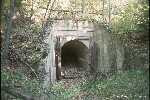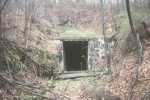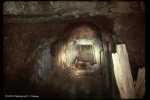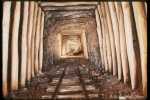





Mile Mark: 25.25
Elevation: 1430'
Date Built: 1873-74
Published Photos: EBT 101, 121, 148, 206
This tunnel was bored between winter 1873 and August 1874 by B. J. McGrann and Company of Lancaster. It was 1228' long and straight. The tunnel headers met in June 1874. It received cut stone arched portals. The tunnel was the watershed break between Aughwick Creek and it tributaries and Trough Creek, a tributary of the Raystown Branch of the Juniata River. Around 1910 the tunnel lining was retimbered. As a result of the derailing of #12 in Sideling Hill Tunnel, this tunnel was also equipped with large wooden doors and a watchman shanty on the North portal. Wray's Hill (somtimes spelled Rays) is a north-south arm off the east side of Broad Top Mountain and contains some coal deposits. As a result of the weak coal seams, this tunnel was more proned to rockfalls than Sideling Hill Tunnel. On June 26, 1919 a severe rainstorm caused a major collapse which closed the line for two weeks. In the reconstruction it received dual concrete portals and was shortened by 90' to 1138'. The south portal was the similar to the Sideling Hill Tunnel's north portal. This portal was arched rather than heagonal as on the other tunnel, but both had similar wing retaining walls. The north portal was flat face with a rectangular entrance. Apparently at this time both portal received rollup doors similar to those on the Rockhill Roundhouse. The north portal was equipped with a watchman's shanty to operate the doors.
The shanty was a small battenboard frame structure with a door, at least one window facing RR Noeth, and a chimeny. The shanty was later coverd with simulated brick asphult siding, like that on Coles Tank and Rockhill San House. Both ends of the tunnel were equipped with tell-tales, which conssted of metal bars hanging from a wire strung across the track about a hundred yards from the portal. The tell-tales would warn brakemen atop the cars of the coming tunnel and also hit any overheight cars or loads.
At some point the rollup doors were motorized, possibly when installed. In 1948 the doors were automated to save money on the tunnel watchmen. The motorized doors were connected to remote actuators on poles a few hundred feet from either portal. A ring hung on a chain from either actuator. The ring before the tunnel was pulled by the head end crew to open the doors and the ring after the tunnel by the caboose crew to close it. Two converted traffic lights on poles just outside either portal showed the status of the door. The lights had three green lenses, and during the winter when the doors were in use all three lights would show green when the doors were open. The signal at the north portal was mounted on and extra high telegraph pole, just outside the engineers side teltale pole. The south portal signal was mounted on the engineer side teltale pole. On at least one occasion the head end crew pulled both rings at one of the tunnels, causing the door to come down on the caboose and be torn off. As a result of this sort of incident the practice of automating the doors was ended by 1952 in favor of a watchman.
The tunnel has suffered many more rockfalls than Sideling Hill, especially at the south end. The south portal is accessible by a three-quarter mile walk along the main from Coles. The shanty at the north portal has nohg since collapsed, though it remains are clearly discernable. Both signals and actuators are gone though the poles and mounts for both actuators are still in place, the south one just inside the Rocky Ridge Passing Siding. The south door has fallen down from its mounting while the north mounting frame and door have toppled outward. DO NOT ENTER THE TUNNEL. It contains debris, standing water and various unfriendly wildlife and is proned to rockfalls.
HAER info at the Library of Congess site>
Back to Coles Curve |
Click on an image to see larger version | Forward to Rocky Ridge |
||
|---|---|---|---|---|
| Up to EBT: Saltillo to Cooks | ||||
| Tour Entry | Tour Index | Tour Info | ||